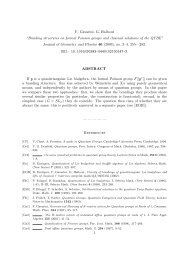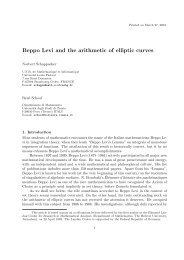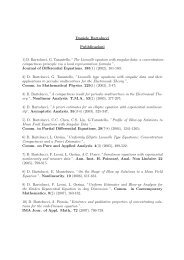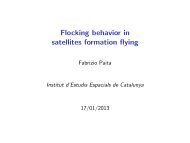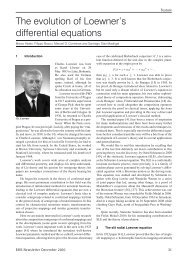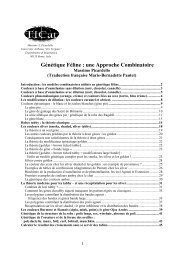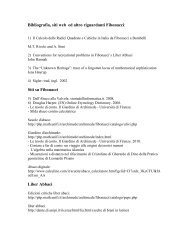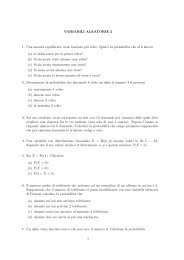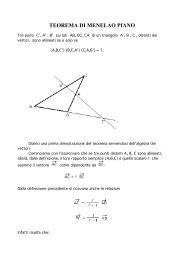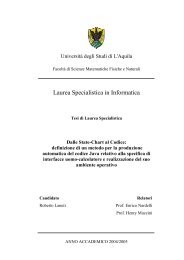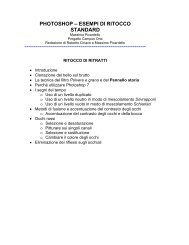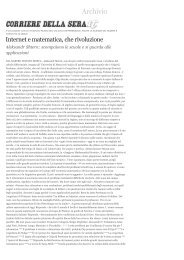Onde e Calore - Dipartimento di Matematica
Onde e Calore - Dipartimento di Matematica
Onde e Calore - Dipartimento di Matematica
You also want an ePaper? Increase the reach of your titles
YUMPU automatically turns print PDFs into web optimized ePapers that Google loves.
Paolo Perfetti, <strong>Dipartimento</strong> <strong>di</strong> matematica, II Università degli Stu<strong>di</strong> <strong>di</strong> Roma, facoltà <strong>di</strong> Ingegneria<br />
F (x) sia derivable (k + 1) volte con continuità e (k + 2) volte a tratti con derivata k 0 + 2–esima<br />
continua a tratti. Sia F (k0+2) (x) =<br />
+∞<br />
(a<br />
n=0<br />
′<br />
n cos nx + b′ n sin nx) e F (k0+1) +∞<br />
(x) = n=0 (an cos nx +<br />
= a′ n /n. Siccome F ′ (x) è derivabile k0 volte con continuità<br />
bn sin nx). Allora an = −b ′<br />
n /n, bn e (k0 + 1) volte a tratti con derivata (k0 + 1)–esima continua a tratti, per ipotesi induttiva,<br />
si ha<br />
+∞<br />
n=0<br />
n k0 ′<br />
(|a n | + |b′ n | < +∞. Ora osserviamo che = |nk0 ′<br />
a<br />
ugualmente per i coefficienti b n , b ′<br />
n<br />
Applicando il teorema, se vogliamo che<br />
da cui la convergenza della serie<br />
+∞<br />
k=1<br />
n | = |nk0+1 a ′<br />
+∞<br />
n=0<br />
n<br />
n | = nk0+1 |an | ed<br />
n k0+1 (|an | + |b n |)<br />
|f k | converga, dobbiamo imporre che F (x) sia con-<br />
tinua con derivata prima continua a tratti. La continuità <strong>di</strong> F (x) deve essere imposta al prolungamento<br />
<strong>di</strong>spari della funzione f(x) e quin<strong>di</strong> deve essere f(0) = 0 = f(L) perché il prolungamento<br />
<strong>di</strong>spari della funzione potrebbe creare una dsicontinuità in x = 0.<br />
Se vogliamo che<br />
+∞<br />
k=1<br />
k|f k |, converga dobbiamo imporre che F ′ (x) sia continua con derivata<br />
prima continua a tratti. La continuità della F ′ (x) è gratis dal prolungamento <strong>di</strong>spari. Infatti<br />
in x = 0 abbiamo lim<br />
h→0 +<br />
1<br />
(f(h) − f(0)) = lim<br />
h h→0 +<br />
f(h)<br />
= lim<br />
h h→0 +<br />
−f(−h)<br />
. Sia ora k = −h, da cui<br />
h<br />
lim<br />
k→0− −f(k)<br />
−k<br />
= lim<br />
k→0− f(k)<br />
k . Negli altri punti la continuità <strong>di</strong> F ′ (x) è data dalla continuità <strong>di</strong><br />
f ′ (x). In x = L vale quanto vale per x = 0.<br />
Se vogliamo che<br />
+∞<br />
k 2 |fk |, converga dobbiamo imporre che F ′′ (x) sia continua con derivata<br />
k=1<br />
prima continua a tratti. La continuità <strong>di</strong> F ′′ (x) va imposta al prolungamento <strong>di</strong>spari <strong>di</strong> f(x).<br />
Infatti in x = 0 abbiamo lim<br />
h→0 +<br />
1<br />
h (f ′ (h) − f ′ (0)) = lim<br />
h→0 +<br />
1<br />
h (f ′ (−h) − f ′ (0)) = lim<br />
k→0− 1<br />
−k (f ′ (k) −<br />
f ′ (0)) da cui f ′′ (0 + ) = −f ′′ (0 − ) e quin<strong>di</strong> dobbiamo imporre f ′′ (0 + ) = 0.<br />
Se invece vogliamo che<br />
+∞<br />
k=1<br />
k q |g k |, q = −1, 0, 1, converga, allora dobbiamo imporre g(0) = g(L) =<br />
0 e che g(x) abbia derivata prima continua e derivata seconda esistente a tratti e continua a<br />
tratti.<br />
21/novembre/2010; esclusivamente per uso personale, è vietata ogni forma <strong>di</strong> commercializzazione 9



